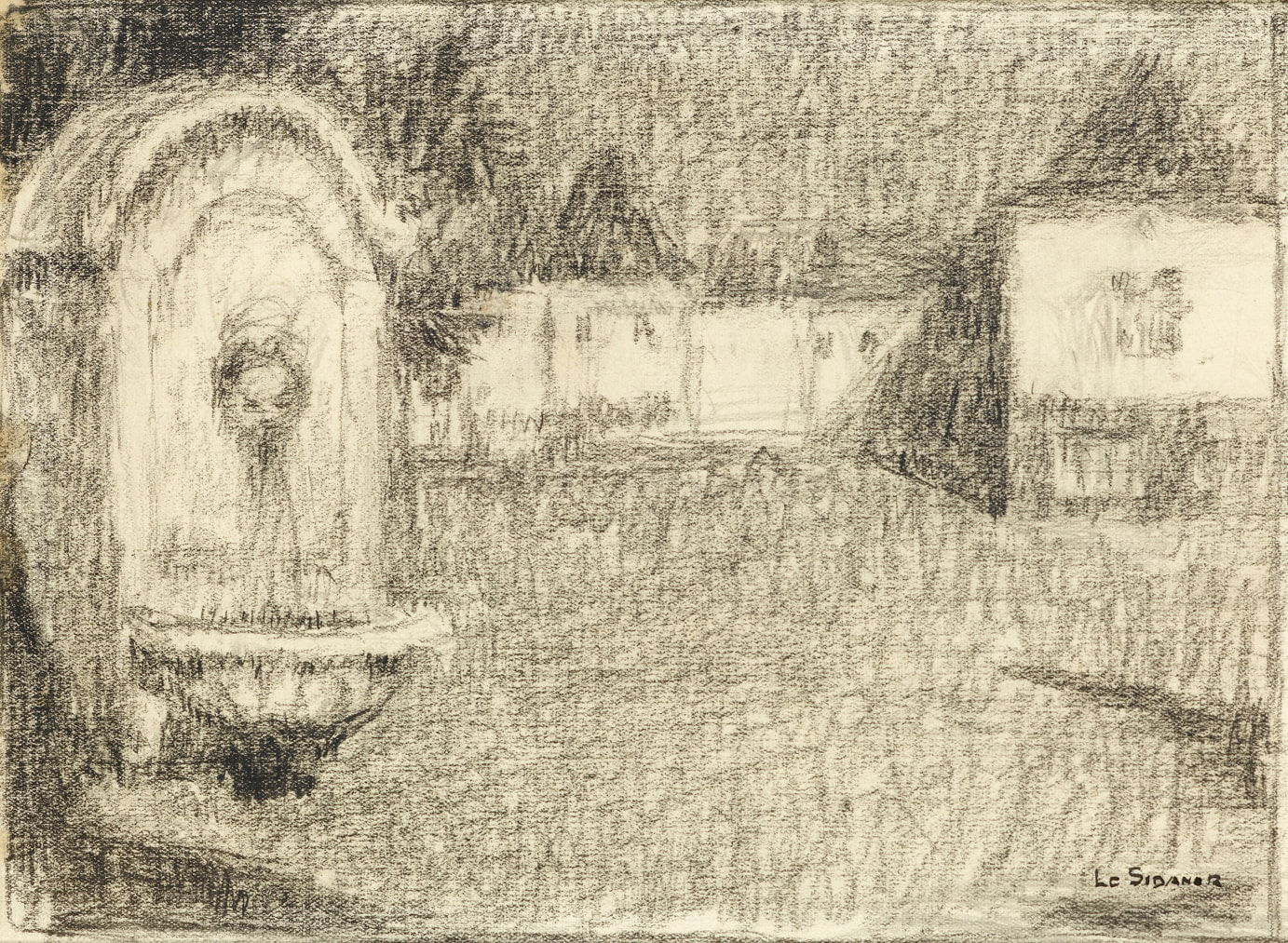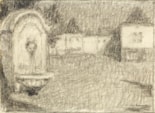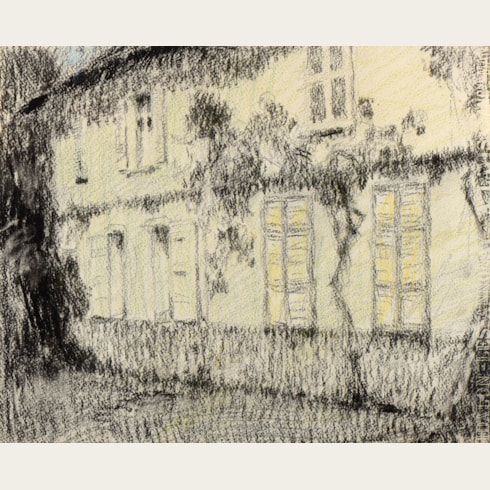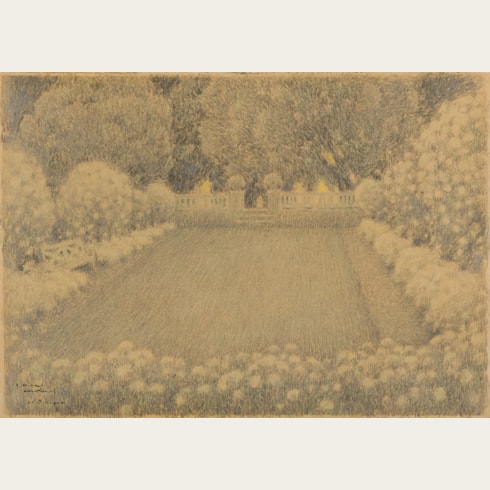Henri LE SIDANER
(Port-Louis 1862 - Versailles 1939)
A Fountain in a Village Square
Sold
Black chalk, on white paper.
A study of houses around a square (probably the same view) in pencil, with touches of yellow, green and red chalk, on the verso.
Signed Le Sidaner at the lower right.
194 x 247 mm. (7 5/8 x 9 3/4 in.) [sheet]
A study of houses around a square (probably the same view) in pencil, with touches of yellow, green and red chalk, on the verso.
Signed Le Sidaner at the lower right.
194 x 247 mm. (7 5/8 x 9 3/4 in.) [sheet]
Henri Le Sidaner’s landscapes and town scenes are almost always devoid of figures. As the painter Paul Signac noted of the artist, ‘his entire work is influenced by a taste for tender, soft and silent atmospheres. Gradually, he even went so far as to eliminate from his paintings all human figures, as if he feared that the slightest human form might disturb their ruffled silence.’
The son of a naval officer, Henri Le Sidaner was born on the island of Mauritius and studied at the Ecole du Dessin in Dunkirk. Although he also spent some time in the studio of Alexandre Cabanel at the Ecole des Beaux-Arts in Paris, which he entered in 1880, Le Sidaner eventually gave up this academic training and in 1882 settled in the coastal town of Étaples, in the Pas de Calais in northern France. There he lived and worked for the next twelve years in isolation, painting views of the surrounding countryside and genre scenes of peasant life. In 1887 he exhibited for the first time at the Salon des Artistes Français in Paris, and he continued to exhibit there yearly until 1893, after which he began showing at the rival Société Nationale des Beaux-Arts. In 1894, the same year that he first sent his work to the Salon de la Société Nationale des Beaux-Arts, Le Sidaner returned from Étaples to live in Paris. From 1899 onwards, he enjoyed an exclusive arrangement with the Galerie Georges Petit, which handled the sale of all of his paintings until the closure of the Parisian gallery in 1931.
Around 1901 Le Sidaner settled in the small medieval village of Gerberoy, in the Oise department on the border of Normandy and Picardy, where he built a studio and garden and worked until the end of his life. His house at Gerberoy became the dominant subject of his mature work, providing him with motifs and inspiration for nearly forty years. As the artist’s friend and early biographer Camille Mauclair, writing in 1928, noted, ‘he had the good fortune to find an atmosphere and surroundings that suited his nature and his ideas. He was destined to paint much of France, but Gerberoy was and remains his asylum pacis and family home.’ Apart from his travels around France, Le Sidaner also painted in Venice, London and around Lake Maggiore in Italy. In 1910 he was given a retrospective exhibition at the Galerie Georges Petit, while a room was devoted to his work at the Venice Biennale of 1914. In 1930 Le Sidaner was at last admitted into the Académie des Beaux-Arts, a triumph for a painter who had worked outside official circles for most of his career.
Le Sidaner delighted in capturing transient effects of light, and would paint scenes in bright sunshine, twilight, moonlight or even artificial light. As one American critic, writing in 1906, noted of Le Sidaner, ‘His art expression lies somewhere between that of Corot and that of Claude Monet. It is elusive and delightful and stamps him as one of the most original, one of the most exquisite of France’s younger painters…What Sidaner does not know about light and the method of reflecting it on a canvas seems scarcely worth knowing…’
While Le Sidaner often made sketches and drawings sur le motif, his paintings themselves were generally painted from memory rather than direct observation. He was able to achieve remarkable effects of solitude and serenity in his pictures, and chose his compositions carefully to heighten the poetic mood. As another contemporary critic wrote, ‘corners of small towns in winter, glum suburbs, a farm with pallid windows, streets with echelons of feeble, pensive lights form a decor which gives the best possible expression to Le Sidaner's exquisite sensitivity.’ Another French critic, Roger Marx, aptly described the artist’s paintings as redolent of a ‘feeling of peace, of silence and of mystery’.
Around 1901 Le Sidaner settled in the small medieval village of Gerberoy, in the Oise department on the border of Normandy and Picardy, where he built a studio and garden and worked until the end of his life. His house at Gerberoy became the dominant subject of his mature work, providing him with motifs and inspiration for nearly forty years. As the artist’s friend and early biographer Camille Mauclair, writing in 1928, noted, ‘he had the good fortune to find an atmosphere and surroundings that suited his nature and his ideas. He was destined to paint much of France, but Gerberoy was and remains his asylum pacis and family home.’ Apart from his travels around France, Le Sidaner also painted in Venice, London and around Lake Maggiore in Italy. In 1910 he was given a retrospective exhibition at the Galerie Georges Petit, while a room was devoted to his work at the Venice Biennale of 1914. In 1930 Le Sidaner was at last admitted into the Académie des Beaux-Arts, a triumph for a painter who had worked outside official circles for most of his career.
Le Sidaner delighted in capturing transient effects of light, and would paint scenes in bright sunshine, twilight, moonlight or even artificial light. As one American critic, writing in 1906, noted of Le Sidaner, ‘His art expression lies somewhere between that of Corot and that of Claude Monet. It is elusive and delightful and stamps him as one of the most original, one of the most exquisite of France’s younger painters…What Sidaner does not know about light and the method of reflecting it on a canvas seems scarcely worth knowing…’
While Le Sidaner often made sketches and drawings sur le motif, his paintings themselves were generally painted from memory rather than direct observation. He was able to achieve remarkable effects of solitude and serenity in his pictures, and chose his compositions carefully to heighten the poetic mood. As another contemporary critic wrote, ‘corners of small towns in winter, glum suburbs, a farm with pallid windows, streets with echelons of feeble, pensive lights form a decor which gives the best possible expression to Le Sidaner's exquisite sensitivity.’ Another French critic, Roger Marx, aptly described the artist’s paintings as redolent of a ‘feeling of peace, of silence and of mystery’.
Provenance
Private collection, in 1989
P. & D. Colnaghi, London, in 1999
Private collection, Florida, until 2012.
Literature
Yann Farinaux-Le Sidaner, Le Sidaner: L'oeuvre peint et gravé, Paris, 1989, p.336, no.1019 (where dated c.1912).
Exhibition
Paris, Musée Galliera, Rétrospective Henri Le Sidaner, April 1948, among the ‘vitrines d'études, dessins, etc.’






